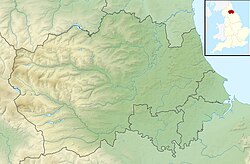| UNESCO World Heritage Site | |
|---|---|
 Durham Castle - view from within the Castle courtyard | |
| Location | Durham, County Durham, England, United Kingdom |
| Criteria | Cultural: (ii), (iv), (vi) |
| Reference | 370 |
| Inscription | 1986 (10th Session) |
| Extensions | 2008 |
| Coordinates | 54°46′29″N1°34′34″W / 54.77472°N 1.57611°W |
Durham Castle and Cathedral is a World Heritage Site (WHS ID No. 370), [1] in Durham, England.
The site includes Durham Castle, Durham Cathedral, Durham University, Durham Cathedral College, Palace Green and University College, Durham.
It was first given World Heritage Site status in 1986, and its boundaries were modified in 2008. [1]
